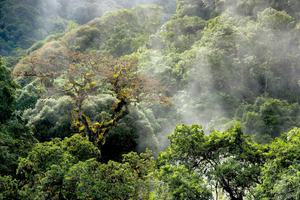Sagebrush steppe in Owyhee County, Idaho. Famartin via Wikipedia
Every year, the West loses 1.3 million acres of its iconic sagebrush steppe, according to the newest report from a multi-agency group working to conserve this important ecosystem. That’s roughly 2,000 square miles — an area about the size of Grand Canyon National Park, or four times the sprawl of Los Angeles.
The largest terrestrial biome in the Lower 48, sagebrush rangeland spans 13 states and once covered a third of the continental U.S. Now, roughly half of it is gone. The new report, released in September, includes maps that show the full scale of the loss since 2001 and identify its causes. It’s the latest step in an effort by 94 scientists and specialists from 34 government agencies, universities, and nonprofits to catalog large-scale threats to the sagebrush biome. Later this winter, the group plans to publish a rangeland-wide set of priorities and strategies to conserve the roughly 115 million acres that remain.
“The fact that we’ve already lost half (the sagebrush rangeland), as far as function and intactness, is mind-blowing,” said Matt Cahill, head of the Nature Conservancy’s Sagebrush Sea Program, who helped produce the report. “Without a healthy sagebrush biome, we’re going to see life in rural America in the West become increasingly intractable.”
The new maps, created using satellite imagery and two decades of Bureau of Land Management data, are groundbreaking in their scale. There have been more limited efforts in states like Oregon, but the new maps offer the first comprehensive look at the entire sagebrush biome. In them, habitat is categorized at three levels: core ecosystem with little degradation, “growth areas” that are still recoverable, and rangeland that is too damaged to restore using currently available tools.
The data shows that 73 percent of the loss — by far the largest amount — stems from ecosystem problems: invasive annual grasses, wildfire, conifer encroachment. Just a quarter of it is due directly to human activities like grazing cattle and developing energy infrastructure. While many of the issues are related, this means weed management may ultimately prove a more effective — and less controversial — strategy than regulation. “At the end of the day, everybody hates weeds,” said Zack Wurtzebach, a program director at the Center for Large Landscape Conservation who helped develop the report.
The maps are part of a larger project expected to culminate this winter in a biome-wide sagebrush conservation strategy. Though conservation at this scale has few precedents in the U.S., it’s not the first such effort: The project is modeled after the North American Waterfowl Management Plan, through which thousands of partners have restored and protected tens of millions of acres of wetlands since the 1980s.
The new sagebrush conservation approach is simple: Agencies, lawmakers, tribes, landowners and other stakeholders would collaborate to defend the intact core areas of the ecosystem and restore those areas that can still be recovered. The strategy is proactive, designed to focus funding on the places where it will be most effective. “Nothing makes a better story than ‘Look at this field of weeds that I brought back to beautiful native sagebrush steppe,’ right? But unfortunately, that’s just not possible in a lot of places,” said Megan Creutzburg, coordinator of SageCon, a collaborative conservation partnership in Oregon, who helped develop the interagency report.
The new strategy marks a major shift: A single species, the greater sage grouse, has been the longtime focus of conservation efforts in the region. The revised approach is much broader, considering threats and priorities across the entire ecosystem, which supports 350 other species, including birds, pygmy rabbits, and native grasses. “And it isn’t just animals; it’s livelihoods, it’s economies,” said Tony Wasley, director of the Nevada Department of Wildlife. His agency will use the maps to inform things like land-use policy related to mining and where to prioritize revegetation projects after wildfires.
The strategy won’t dictate specific local actions; interagency group leaders emphasize that local knowledge and partnerships will be essential to future projects. But they hope a more comprehensive set of priorities will help leaders access the newly available funding from the Biden’s administration’s infrastructure and inflation reduction bills.
“We’re never going to reclaim all of the biome that we’ve lost,” Cahill said on a webinar launching the new report. “But we can make a serious step forward in preserving what we have and growing it to a sizable extent so we’ve [still] got a sagebrush biome in 2050.”
—Sarah Trent, High Country News
ALSO ON YALE E360
How Returning Lands to Native Tribes Is Helping Protect Nature



